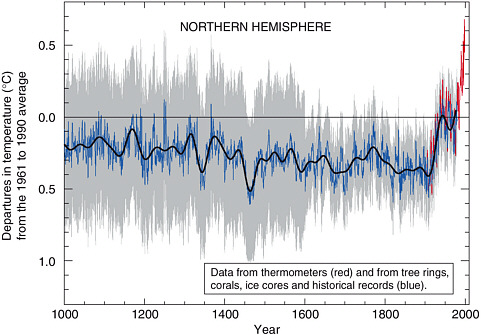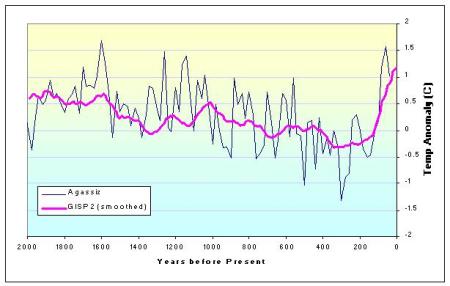An Antarctic ice core for example has a realistic time resolution limit of 140 yrs no matter how thin you slice the core or what tricks you use. OTH -- Ice cores from Greenland can be sliced thin enough (if you have enough time and money) to get about 80 years limiting resolution.
This is because Antarctica is a desert. Very slow ice building. While Greenland is many times as rapid. So there might 8 times more YEARS per slice in a Vostok core than a Greenland per centimeter.
Here's a HIGH resolution ice core sample from Greenland that covers most of the hockey stick period. NOTE the Roman warm period is there, as is the MedWarm period and the Little Ice Age. Doesn't look ANYTHING like the GLOBAL hockey sticks but yet it recorded events WE KNOW HAPPENED.
 GISP2 Greenland Ice Core Data, RBAlley (2000)
GISP2 Greenland Ice Core Data, RBAlley (2000) by
OldNick_nor, on Flickr
Paleoclimatic records show that the Greenland Ice Sheet consistently has lost mass in response to warming, and grown in response to cooling. Such changes have occurred even at times of slow or zero sea-level change, so changing sea level cannot have been the cause of at least some of the ice-sheet changes. In contrast, there are no documented major ice-sheet changes that occurred independent of temperature changes. Moreover, snowfall has increased when the climate warmed, but the ice sheet lost mass nonetheless; increased accumulation in the ice sheet's center has not been sufficient to counteract increased melting and flow near the edges. Most documented forcings and ice-sheet responses spanned periods of several thousand years, but limited data also show rapid response to rapid forcings. In particular, regions near the ice margin have responded within decades. However, major changes of central regions of the ice sheet are thought to require centuries to millennia. The paleoclimatic record does not yet strongly constrain how rapidly a major shrinkage or nearly complete loss of the ice sheet could occur. The evidence suggests nearly total ice-sheet loss may result from warming of more than a few degrees above mean 20th century values, but this threshold is poorly defined (perhaps as little as 2 C or more than 7 C). Paleoclimatic records are sufficiently sketchy that the ice sheet may have grown temporarily in response to warming, or changes may have been induced by factors other than temperature, without having been recorded.
https://www.geo.umass.edu/faculty/jbg/Pubs/AlleyetalQSR2010Greenl.pdf
Richard Alley’s name has been thrown around a bit by bloggers asserting that ice-core records from Greenland show
that carbon dioxide has scant, if any, influence on climate. Dr. Alley, a glaciologist and climate scientist at Penn State, is a longtime contributor to the Intergovernmental Panel on Climate Change, author of a nice history of ice and climate, “
The Two-Mile Time Machine,” and — as many Dot Earth readers are aware — a teacher with
musical and
terpsichorean talents (see the YouTube video below for his orbital dance explaining how ice-age cycles help show the amplifying power of greenhouse gases).
Reality Check on Old Ice, Climate and CO2
Above is Dr. Alley's research and opinion on the affect of the present increase in CO2 by humans, and how it is warming the Earth.


 GISP2 Greenland Ice Core Data, RBAlley (2000)
GISP2 Greenland Ice Core Data, RBAlley (2000)

